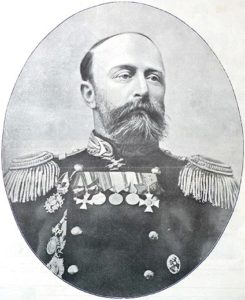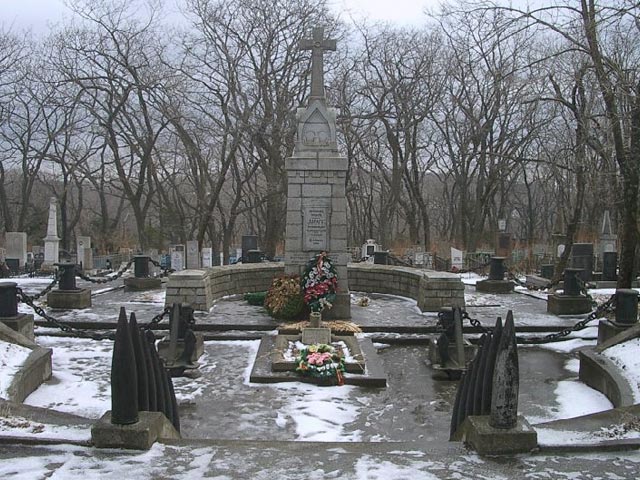More than 300 years ago at decree of Peter the Great St. Andrew’s flag was raised on Russian ships for the first time. Since then quite a lot glorious pages have been added to naval history. But cruiser Varyag, that refused to lower a banner in front of enormous enemy squadron in 1904, has been remained in people’s memory as the striking symbol of courage, self-sacrifice and military valour.

On the 27th of December in 1903 the captain of Varyag cruiser Vsevolod Fedorovich Rudnev received an order from Russian deputy to enter the Korean international port Chemulpo (present-day port Incheon, South Korea). On a plan of command the cruiser had to establish trusted connection between Port Arthur and our envoy in Seoul as well as designate Russian military presence in Korea. It was forbidden to leave port Chemulpo without orders of senior command. Because of complicated fairway and shoal Varyag anchored in the outer road. In a few days gunboat Korietz jointed her. It was very clear soon that the Japanese began to prepare for widespread landing operation. On the 25th of January the captain of cruiser Rudnev headed for Russian ambassador personally to take him and go home with the entire mission together. But Ambassador Pavlov could not dare to leave embassy without order of his department. In 24 hours port was blocked by armada of Japanese squadron. It had 14 ships. Flagship was an armoured cruiser Asama.

On the 27th of January the captain of cruiser Varyag got an ultimatum from Admiral Uryu. Japanese commander demanded to leave the port and surrender to the mercy of winners. Otherwise he threatened to attack Russian ships right on the raid. After being notified of that, ships of the foreign states made protests against the fight in neutral road. At the same time they refused to escort the Russians to the open sea. In that place the Russian ships might have had more room for maneuver and repelling an attack.
They started getting ready for a battle on cruiser Varyag and gunboat Koreitz. By tradition all the sailors and officers changed their shirts. At 10:45 Rudnev addressed a crew. The priest blessed seamen before the action.

At 11:20 cruiser Varyag and gunboat Koreitz weighed anchor and went towards the Japanese squadron. As a sign of admiration French, English and Italian crews were lined up on the decks. On Varyag the orchestra played the national anthems and in response the anthem of Russian Empire was heard on Italian ship. When Russian ships emerged in the road the Japanese lifted a signal and ordered to surrender. The captain told not to respond to enemy’s signals. For several minutes Admiral Uryu was waiting for an answer in vain. In the beginning he could not believe that Russians were not going to surrender but attack his squadron. At 11:45 flagship Asama opened fire on cruiser Varyag. One of the first shells got into upper forebridge and destroyed range finding station. Main battle top was lost. In two minutes Varyag fired back with starboard guns.
It was especially hard for commanders on the upper deck. For the first time the Japanese put into battle a new tactic – they nearly covered cruiser Varyag with high-explosive shells. Even on water such a shell burst into hundreds of pieces.
Russian Fleet used powerful armour-piercing shells. They broached sides of enemy’s ships without any explosion.
Blood, burnt arms and legs, torn up bodies and meat were everywhere. Wounded people refused to go away. Only those who could not stand got to sickbay. Upper deck was broken through in several spots. All the ventilators and grates were riddled. After the explosion the ensign was torn away but boatswain’s mate raised the new one with the risk to his life. At 12:15 Rudnev decided to use the port side guns in fighting. While the ship was turning two large shells hit her at once. The first one struck into the room with all the steering linkage. Fragments of another flew into conning tower. Three people next to Rudnev were killed on the spot. Captain by himself was shell-shocked in head but in spite of contusion he stayed on his post and kept on commanding the battle. When the distance between enemies shortened to 5 kilometers the gunboat Korietz engaged.
It is very wonderful but neither of Japanese shells was able to hit it. The day before the captain ordered to shorten masts and it hindered Japanese in their effort to define the distance and correct fire.
At 12:25 Varyag opened fire with port guns. After-bridge of Asama was annihilated with direct hit whereupon there was a fire on the flagship. By that moment the second cruiser Takachiho was forced to leave the battle with major damage. One of the torpedo boats sank. At 12:30 two shells hit side of the cruiser Varyag under the water. Cruiser began to list at port side. While the crew was placing patch and pumping water, Rudnev decided to come back to port Chemulpo. In the road he thought to mend the damage and put out fire in order to be back to battle later again.
At 12:45 approaching the road they ceased general fire. During battle Varyag managed to launch 1105 shells against the enemy. At 13:15 Varyag all in wounds and smoke anchored in the road. According to eyewitnesses, the whole deck was covered in blood. In the smoked cabins of the cruiser there were 130 wounded sailors. 22 people fell in battle. There were two of the twelve 6-inch guns in working state. Any further resistance was impossible. And then council of war took a decision to scuttle the ships so that they not go to the Japanese. They also concluded to house the crew on foreign vessels by agreement. Accepting an appeal from Rudnev the captains of European ships sent boats with medical orderlies. In the course of evacuation some sailors perished. French cruiser Pascal took the largest part – 352 people. The English took 235 people and the Italian – 178. At 15:30 kingstons and flood valves of Varyag were opened. Korietz was blown up.
On the 9th of February 1904 at 18:10 the light armour-deck cruiser Varyag rolled over on her port side and disappeared under the water.
None of the officers and seamen was captured after the battle. With respect for bravery in battle Admiral Uryu allowed them to go through combat zone for homecoming.
In two month a steamboat with sailors from Varyag and Koreitz arrived to Odessa. Heroes of Chemulpo were welcomed with loud sounds of orchestra and manifestation of many thousands. Sailors were thrown with flowers and all it happened with an incredible display of patriotic affection. All the participants of the battle were awarded with St. George crosses. Each seaman got an engraved watch from the Emperor. The first songs devoted cruiser Varyag and gunboat Korietz appeared at that time.
The second life of cruiser Varyag.
However it was not the end of Varyag’s history. Soon after the battle it turned out that Varyag did not sink much deep. At low tide water level in bay Chemulpo fell to 9 meters. Finding out it the Japanese began the work to raise cruiser Varyag. Within a month divers and specialized equipment were delivered from Japan. All the guns, masts and tubes were dismantled off the cruiser. They unshipped coal. But all the attempts to lift up cruiser in 1904 failed. Only on the 8th of August 1905 after making special caissons it became possible to pull cruiser out of the muddy bottom. In November 1905 Varyag went to Japan on her own course. Nearly two years cruiser Varyag was in Yokosuka for complete overhaul. Japan’s treasury paid 1 million yen for reconstruction and lifting. In 1907 she was incorporated into Imperial Japanese Navy under the name Soya. As a mark of respect to enemy the previous cruiser’s name was abaft. During nine years the cruiser was a training ship in Cadet College. It was taught there how to defend the honor of your motherland.
After the First World War the Russian Government started negotiations on transfer of several trophy ships. The Russian Government bought Varyag back from the Japanese after long bargaining. In March of the same year cruiser went to Russia. On the 21st of March 1916 thousands residents of Vladivostock watched three Russian ships enter bay Zolotoy Rog flying the Japanese flag. There were the battleships of the first Pacific squadron Poltava, Peresvet and legendary cruiser Varyag. In 12 years cruiser unmoored home banks. Those ships were accepted as members of Russian Fleet again. Since then they were staffed only with guard teams.
At the end of 1916 cruiser Varyag was taken on the staff of the Arctic Ocean Flotilla. Soon it was decided to have Varyag overhauled in England. In 1917 she arrived to Liverpool. The future of Varyag went tragically. Receiving the news about October coup in Russia the Whitehall ordered to detain all the Russian ships in the ports. By that moment the repair cost of Varyag was estimated in 300 000 pounds. When it turned out that Bolsheviks were not going to pay the tsar’s debts the Englishmen seized Varyag and a short time later sold on it to one of the German firms for scrapping. On the 5th of February 1920 two tugboats started towing her to the port of Glasgow. There was a great storm in Irish Sea while towing. Off the coast of South Scotland Varyag crashed the cliffs and sank as a matter of fact not so deep. When the tide was low the cruiser’s hull stuck out of the water nearly 2 meters. All the efforts to get a ship off the cliff did not succeed. Then new owners began to cut up her right in the sea. In 1925 all the work on the spot of Varyag’s wreck was accomplished. The destiny of legendary ship was completed such way. But the feat of her crew has not fallen into oblivion.
On the 9th of August 1992 the monument to cruiser’s captain Rudnev was unveiled. In summer 1997 the monument to cruiser Varyag was erected in Vladivostok.
This exploit has become a symbol of fortitude and bravery of Russian sailors. That is why they in the Pacific and dwellers of Vladivostok meet at the maritime cemetery annually to pay respects to seamen of cruiser Varyag and gunboat Korietz.
